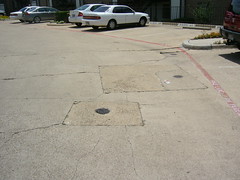 It’s a common platitude used by health professionals, but as often is the case with platitudes, it’s true. In particular, we could probably all be diagnosed with a couple very mild forms of “personality disorder” at any given time. Why? Well, we all have a personality, don’t we? A disorder only relates to the degree these traits affect our lives.You see, we all have coping mechanisms we use to get by in the world, little techniques that have served us well in the past, things that we are good at, things that work. This is normal and these behaviours form a part of our personality (outgoing, shy, aggressive, passive etc). It’s only when these behaviours get in the way of our daily functioning that they are classed as a “disorder”.
It’s a common platitude used by health professionals, but as often is the case with platitudes, it’s true. In particular, we could probably all be diagnosed with a couple very mild forms of “personality disorder” at any given time. Why? Well, we all have a personality, don’t we? A disorder only relates to the degree these traits affect our lives.You see, we all have coping mechanisms we use to get by in the world, little techniques that have served us well in the past, things that we are good at, things that work. This is normal and these behaviours form a part of our personality (outgoing, shy, aggressive, passive etc). It’s only when these behaviours get in the way of our daily functioning that they are classed as a “disorder”.
For example, a shy person may avoid getting him or herself into unfamiliar social situations and may feel a little socially inept at times. As a shy person myself, I can assure you this is normal. If, however, this shyness becomes the focal point of someone’s life, it may develop to the point of avoidant personality disorder, which is a very real, very serious condition.
So, how do we know what kind of disorder we have? The DSM-IV-TR is the bible of mental disorders. It lists all the recognized disorders, symptoms and diagnoses. In other words: it’s a hypochondriac’s dream. Give yourself 5 minutes with this book and you’ll have diagnosed yourself with everything from PTSD to ADHD. What interests us here is personality disorders, on axis 2. They are: Paranoid, Schizoid, Schizotypal, Antisocial, Borderline, Histrionic, Narcissistic, Avoidant, Dependent, Obsessive-Compulsive and the nebulous “Not Otherwise Specified“.
Going to Stephen’s therapy sessions has been interesting not only for treating him, but also treating me. My primary coping mechanism when I get under stress is a need to obsess over every single detail of that particular stress. I have learnt in the past that the best way to deal with something is to understand it. For example, when I first came out, I wrote down every single sexual thought that ever entered my head in the last 25 years. I then analysed every single sentence over and over again. When I realised Stephen was ill, I documented every little thing I knew about him and recorded just about every conversation I had with him in case the information would be useful later. I became hypervigilant, to the point where I stayed up all night one night because he didn’t come home when I expected him to (I am told this is probably post traumatic stress from having to deal with Stephen’s suicide attempts).
So, as you probably guessed, if I had to choose a disorder on the list, it would be obsessive-compulsive. I am not properly OCD. I don’t have Monk’s quirks, but I certainly do have a few unusual behaviours. For example, most of the things I say are repeated in my head before and after I say them (a kind of pre and post-processing). When I was younger, I used to obsess over washing my hands. That’s something I don’t do anymore. Another obsessive behaviour I exhibit that crops up from time to time is avoiding lines.
I guess avoiding lines could be seen as a way to keep my mind distracted while I am worried about something. I think the idea is: if I am concentrating on avoiding stepping on imaginary boundaries, I don’t have the time to obsess over other things I have no control over (like finding my crazy ex-boyfriend a place to stay).
I say lines and not cracks because I don’t avoid just cracks in the pavement. I avoid every line. Paint lines, changes in surface texture, shadows, parallel lines formed out of other lines. I have posted an image which represents how I see the pavement I am walking on. Move the mouse over the image to see just how crazy I am.
Don’t believe me that we’re all a little bit crazy? Take the personality disorder meme and let’s see what you get. No, don’t be silly, it’s not a real test.The conclusion from all this is: it’s ok to be a little bit crazy, just don’t let it take over your life.